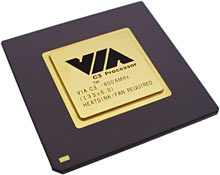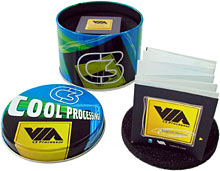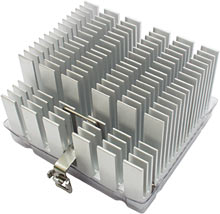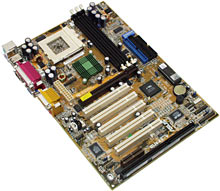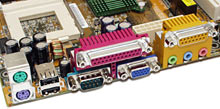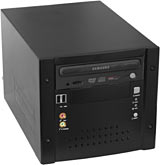
800MHz Via C3 CPU
Review date: 29 September 2001.
Last modified 03-Dec-2011.
Want a Socket 370 CPU that consumes less than ten watts of power?
Well, you've got a problem.
Intel make some pretty fast mobile processors which, in their reduced-clock-speed "battery optimised" SpeedStep mode, consume less than ten watts in normal use. But those chips don't come in the Socket 370 form factor; you can't plug them into a normal desktop computer motherboard.
AMD can't help you, of course. Their Mobile Athlon 4's fast, but it'll want more than ten watts for even quite light computing, and it's Socket A anyway. No can plug into Intel-chip motherboard.
So say hello to Via, and the C3. Which used to be the Via Cyrix III, except it wasn't really.
This is a bit confusing. Stick with me.
What's now called the C3 has gone through a few names and designs since its creation.
Via bought Cyrix in June 1999, and used their "Cayenne" core, which Via referred to as "Joshua", in the original "Via Cyrix III".
That chip never made it to market, though, because a month and a bit after buying Cyrix, Via bought Centaur. They then adopted the Centaur "Samuel" core for the next model of Cyrix III. The resultant processor had nothing in particular to do with Cyrix, but Via stuck to the name they'd been promoting, to avoid inducing migraines in their customers.
The Centaur team have produced two more generations of this processor, now; first the Samuel 2, and now the new super-small, super-cool (in the temperature sense, not in the reminds-you-of-the-young-Marlon-Brando sense) Samuel 3, also known as "Ezra". The Cyrix III name's been dropped, now, and the processor's called the Via C3.
The flagship C3 is the 866MHz model, whose official release date was the 11th of September, 2001. The C3 release was not quite the most exciting thing that happened on that day, but it's nonetheless in the market now. Via sent me an 800MHz processor to play with. It uses the same core as the 866MHz model, and has 92% of its clock speed, so it's basically the same thing as the top-spec CPU.
The Samuel-core C3s, or Cyrix IIIs, or whatever the heck you want to call them, weren't high performers. Particularly for tasks with lots of floating point calculations, at which the Centaur cores, well, suck. But that wasn't a big deal, since these chips were and are aimed at the OEM business computer and low-power pseudo-embedded appliance markets.
If you want a cheap, simple office application box, or if you want a quiet little Windows 2000 machine to do TCP/IP appliance tricks that a very low powered Linux box can handle, then one of these chips would do just fine. It'll also do for all sorts of undemanding home computing tasks, and it's got a niche in the Linux/FreeBSD market, too; if your application needs more grunt than a dirt cheap superannuated P-166 offers, or needs things like USB that those old computers don't have, but you still want a computer that doesn't suck a ton of power or make a lot of noise, then a C3 could be the CPU for you.
Clearly, some hopeful marketing people at Via want regular consumers to buy C3s, as well. Otherwise, there's not much justification for fancy promotional retail packaging like that shown in the above picture.
Does the Ezra core and higher clock speed make the C3 a real contender in this market? What is it good at? Can it really run without a fan?
Read on.
The heat thing
Like all CPU companies, Via can bang on at great length about the technical details of the C3's architecture. 0.13/0.15 micron manufacturing processes, 128K L1 cache, 64K L2 cache, 133MHz Front Side Bus (FSB), dual overhead pipelined induction moustache snoods.
The only one of these chip-head specifications that really matters to people buying the thing, though, is the Thermal Design Power, or TDP. TDP is the maximum heat the CPU's cooling system has to be able to dissipate. The CPU will only emit that much heat when it's maximally loaded with the cruelest possible set of instructions, which is not something that's likely to happen in the real world. The actual average power draw, and consequent heat output, is likely to be considerably lower. But just in case you do manage to hit TDP for any significant length of time, it's a really good thing if your CPU doesn't overheat as a result.
Other current desktop-computer processors have high enough TDPs that cooling them with a simple passive heat sink, sitting there in the mild air flow created by the single power supply fan that's all that cools most cases, isn't an option. You could do it, if you redesigned the motherboard so that a heat sink the size of a shoebox could be crammed in somewhere, maybe with a heat pipe to feed it. But it's much more elegant to have a much smaller heat sink with air forced over it by an attached fan, and so that's what we've all got used to seeing on our processors.
At 800MHz, the TDP of an Ezra-core C3 is 8.5 watts, according to Via. The "typical" power figure is only five watts.
As a result, this is all you're meant to need to cool it. Heat sink, passive, one. I recently tested this sink with and without a fan as part of my cooler comparison. With a fan, it performed perfectly well, but without one it had less than a third of the heat-dissipating power of even the modest bargain-bin fan-equipped coolers.
But that's OK, because on the C3, it only has to dissipate a third or less of the heat that's output by other "entry level" desktop processors.
AMD's Mobile Athlon 4 should be useable in desktop machines, if you're feeling kinky, but its TDP is 22W for the 850MHz version, ranging up to 25W for the 1100MHz one.
The current model 0.13 micron "Tualatin" Pentium IIIs have a TDP of 29.1 watts for the 1.13A model (a 1.13GHz CPU that works, as opposed to the last one), and 29.9W for the 1.2GHz model. The 800MHz Celeron, the first model to use a 100MHz FSB instead of the old 66MHz, has a TDP of 20.8 watts.
So, in this department, the C3 certainly wins. When I tested it, even under serious benchmark loads, the heat sink got a bit too warm to comfortably keep your hand on, but was well below crash temperatures.
But does this matter?
Low power - should you care?
For the same reason that the C3 can be expected to only need 5W in normal use, a Tualatin P-III can be expected to use less than 20, and an 800MHz Celeron can be expected to use less than 15. Let's say you're picking between the P-III and the C3, a 15 watt average difference. What difference will that make?
Any PC that's actually doing something will be consuming the thick end of a hundred watts. Flat minimum. Possibly quite a lot more, even if you're not talking about a fire-breathing 3D games box.
The motherboard and cards and drives and the power supply itself in a desktop machine consume some tens of watts between them, when you're actually doing stuff. And if you've got a CRT monitor, you'll find that even a plain 15 inch screen will consume most of a hundred watts all by itself. Ratings of about 75 watts, for normal use, are common. The bigger the screen, the higher the power draw; a 21 incher is likely to want something like 120 watts. Older monitors may draw substantially more.
In basic blanked mode that power consumption drops significantly, and in the deeper standby modes - the ones that a monitor can't just blink straight out of - you're generally talking less than five watts. But a computer whose monitor is in standby and whose hard drive has spun down is a computer whose CPU isn't doing much, either. The difference between a P-III and a C3 in this situation becomes trivial.
If you've got an office with 200 PCs in it and you kit them out with five watt fanless C3s instead of 15 watt fan-cooled Celerons, that will indeed be a saving of more than two kilowatts (more than 2kW, because cooling fans need a bit of power too).
Two kilowatts in a 200-PC office doesn't add up to much, though, even after you consider that it's 2kW less heat for the air conditioning to deal with. Even if all of the PCs have LCD monitors, they'll still draw more than 15kW between them. Use cheap CRTs, as most people not made of money still do, and your "low power" C3 PCs will be drawing a quite comfortable 40kW between them.
And that's not all, of course; there's no way the place is going to need less than 5kW of lighting, even if you go with fluorescents. So you're not going to do a lot to your bottom line by opting for low power CPUs.
If you've got a heating bill to worry about, by the way, then lots of hot computers around the place will actually help a bit. They'll give you one watt of heat output for every watt of electricity they consume, just like a normal electric heater. Gas or reverse cycle air conditioning may be more cost effective, but computers keeping the place warm as well won't hurt.
So if you're not running your house on solar power, or something, the power consumption difference between a C3 and one of the other "basic PC" processors isn't important.
The noise difference can be considerable, though, as I found out when I tested the C3.
Matching mainboard
C3 CPUs should work fine on pretty much any somewhat recent Socket 370 motherboard, as long as the board can deliver the low core voltage (1.35V) the processor wants.
Some motherboards will recognise the C3 just fine and report its identity correctly on startup. Many will need a BIOS update to do that, but even if such an update isn't available yet, the CPU will still work. You may get a nonsensical startup CPU ID display, but that's just a cosmetic problem. Only if your motherboard refuses to start at all when it doesn't know what CPU it's got will your PC truly fail to proceed.
Via provided an Asus CUV4X-V motherboard with my review C3. It's thoroughly representative of the sorts of boards on which C3s are likely to be installed.
This board's a quite standard "all-in-one" offering; it's got audio and video built in, so you don't need to buy separate cards. It uses Via's own ProSavage PM133 chipset.
I've had a look at a board driven by a different ProSavage chipset before (the Asus A7VL-VM Socket A board, which uses the ProSavage KL133; the article is here), and this one's got the same video and sound capabilities. Which is to say, perfectly OK basic audio hardware, and a video adapter that's unacceptably slow from the point of view of a 3D gamer, but perfectly adequate for any normal 2D application.
The ProSavage video adapter pinches 8Mb of main memory for its own use, but that's not a big issue. Since quality 256Mb modules only cost about two-thirds more than 128Mb ones, it's easy to kit out even a basic machine with enough memory for serious work in Windows 2000 or XP. The 95-series OSes, including Windows ME, are less demanding.
The CUV4X-V's got perfectly good specs in other departments. Five PCI slots, one ISA slot, three memory slots, one AGP slot. An AGP Pro slot, yet, though nobody building a basic computer is at all likely to want to use an AGP Pro graphics card.
This is a full ATX-sized motherboard, though; you can't fit it into a really tiny case. If you want your basic PC to be smaller than usual, there are various microATX boards with video and audio built in which sell for less than $AU250 mark, delivered.
You don't have to pay much more to get a board with a 10/100BaseT network adapter built in as well. Actually, you can pay less. The Asus CUSI-M, for instance, has video and sound and LAN built in, and sells for $AU214.50, delivered, from Aus PC Market. Its SIS 630E chipset makes the ProSavage look like a 3D speedster, but people kitting out their offices with the things are likely to consider that a feature, not a bug. If the employees want to play games, they can do it when they're at home, darn it!
Making numbers
I gave the CUV4X-V 192Mb of PC133 RAM (reduced to 184Mb by the video adapter's pilfering), a power supply, a drive and a fresh Win98SE install with all the usual patches and updates. And then I proceeded to see how the C3 stacked up against an Intel chip.
No fair putting the C3 up against a current model P-III, of course. Never mind power consumption and heat; the C3 is a budget chip, and new P-IIIs are quite expensive, partly because Intel's ramping down production. You're looking at $AU450 or more for a 1GHz retail-box P-III at the moment.
But you can pick up an 800MHz Celeron for $AU154, retail boxed and delivered from Aus PC Market.
That's still likely to be a bit above the C3's price point, though. Provided you shop in the right place.
Here in Australia, BCN Technology currently lists the retail-boxed 800MHz C3 for $AU175.81 retail, not including delivery. Actually, their masterful price calculation system means they list it at $AU175.8091. Via assure me that that price is out of date, though; the real retail price for a boxed 800MHz C3 should be about $AU130. That's about $US64, as I write this.
I couldn't even find a listing, much less a price, for the 800MHz C3 on any of the US dealer sites linked from the Via distributor/reseller list here. They're not on Pricewatch yet, either.
People are still selling 566 to 700MHz Celerons, and the US ex-shipping prices for all of those are around the $US35 mark. Let's assume you're not brave enough to buy from one of the bottom-feeders who show up at the top of the Pricewatch lists, and you're instead thinking of paying a whole $US50 for, say, a 600MHz Celeron.
700MHz C3s, using the earlier Samuel 2 core, are going for around $US40 from the suspiciously-cheap brigade.
Let's be charitable, and say that once the silly release prices evaporate, an 800MHz C3 will cost the same as a 600MHz Celeron. Just for the sake of argument.
I've got a CPU that performs not unlike a 600MHz Celeron. It's my old Coppermine P-III, a CPU that Intel gave me back when a P-III running faster than 500MHz was a pretty darn nifty chip. This processor has been peacefully chugging away at stock speed in my print server for a while, now. And it of course works fine in the CUV4X-V.
At 500MHz, it performs a little worse than a 600MHz Celeron, but there's not much in it. Surely the C3, clocked 60% higher, would do OK compared with this superannuated chip?
Out with the benchmarks.
I started with Ziff-Davis' Business WinStone 2001 v1.02, which is unquestionably the most thorough and tedious benchmark ever to produce just one lousy performance number at the end. This test runs big chunks of prerecorded real program tasks on your computer, and the number it spits out at the end really does give you a good idea of that computer's general speed for boring business tasks of some weight, as opposed to mere light e-mail and word processing.
The 500MHz P-III scored 21.8; the 800MHz C3 scored 20.4.
Those are both perfectly OK results for a basic business computer; lots of people are still slogging away on office boxes that'd manage a Business WinStone score well below 10. But despite its lower clock speed and FSB, the P-III still won by 7%.
That's not enough that you'd notice it, but in clock-for-clock terms, correcting for the clock speed gap, it's a 71% difference.
To see what might be behind this result, I tried the CPU and RAM speed tests in WinTune 4.2, a benchmark program that's no longer supported and which never gave anything particularly resembling real world results, but which serves perfectly well as an example of a standard quick and dirty synthetic performance test.
The 500MHz P-III scored 1455 Million Instructions Per Second (MIPS), 575 Million Floating Point Instructions Per Second (MFLOPS), and got 126, 123 and 124, respectively, for WinTune's highly questionable integer, floating point and MMX "application simulations". And its RAM, running at 100MHz with no tweaks, scored an aggregate 1050 megabyte per second figure.
The C3 lost on all of these tests.
In the MIPS test, the P-III only won by 20%. In the MMX application simulation and the RAM test, it won by 33%. The C3 runs from a 133MHz FSB, so its RAM runs faster too, but that didn't help it; another 33% victory for the P-III.
In the integer application simulation, the P-III won by 38%. And in the floating point tests, it became apparent that the Ezra core hasn't done anything in particular to banish Centaur's reputation for crummy Floating Point Unit (FPU) performance. For the FP application test and the plain MFLOPS tests, respectively, the lower-clocked P-III spanked the C3 by factors of 2.08 and 2.83.
Yow.
But not necessarily important.
Remember, business apps don't care about floating point performance. In fact, the only real FPU-stretching tasks that most users run are 3D games.
Back in days of yore - the 386 era and before - FPUs were separate chips, which lots of people didn't bother to buy. Nowadays every CPU's got one built in, but it doesn't need to be particularly muscular, for a large number of tasks.
OK, let's get slightly more realistic.
The distributed.net RC5 and OGR crunching client isn't what most people would call a real world test, either, but it's still something that a lot of people run, and it's not an evil FP-dominant application. The P-III scored about 1.4 million RC5 keys per second and about 3.5 million OGR nodes per second in the distributed.net benchmark. Which put it at 1.38 and 1.51 times the C3's performance, respectively.
For comparison, the Athlon in the computer on which I'm writing this article is chugging along at a nice relaxed 1466MHz, and scores 5,248,340 RC5 keys per second and 12,235,458 OGR nodes per second. A bit less than three times the P-III's clock speed, rather more than three times its performance.
Just for the sake of cruelty, I now did something that C3 buyers aren't meant to do, and fired up Quake III Arena. Setting it to the "Fastest" graphics settings, and then winding the resolution right down to 320 by 240, minimised the influence on frame rate that the ProSavage could have. I ran through the hectic-deathmatch Quaver demo a few times, and the result for the P-III was 52.8 frames per second. The C3 managed 38.2; a 38% win for the Pentium III.
I ran 3DMark 2000 on the last ProSavage board I played with, just to be cruel to the video hardware. The standard 1024 by 768 test delivered a score of only 796 3DMarks, even with the system powered by a not-too-weedy 1GHz Athlon.
The 500MHz P-III on the CUV4X-V delivered 938 3DMarks, which was odd. Continuing this perversity with the C3 produced an even higher score - 1034 3DMarks. Which startled me somewhat.
The Socket A A7VL-VM ProSavage board uses 16 megabytes of main memory for its graphics adapter, and only has one 128Mb memory module, while the CUV4X-V uses only 8Mb, and has 192Mb of RAM. Perhaps the C3 machine was skipping some tests and getting better numbers that way, I thought. Or perhaps the Athlon box was running out of RAM and flogging its drive. That wouldn't explain the difference between the C3 and the P-III, though.
And that wasn't it, anyway; both computers were running the same test set, and the Athlon seemed not to be hitting its disk.
And it wasn't the drivers; I installed the latest ProSavage drivers on each computer, and the scores remained the same, within 3DMark's small error margin.
Perhaps the Socket 370 ProSavage chipsets are just better engineered for 3D graphics, or at least the Direct3D 3D graphics used by 3DMark 2000's engine, than the Socket A ones. Search me as to why the C3 got a better score than the P-III for this test, though. The difference in RAM speed between the P-III's 100MHz and the C3's 133MHz, perhaps? It didn't help for Quake III, though.
A 3DMark 2000 score of about a thousand, by the way, is still not at all exciting. A 500MHz Celeron box with a dirt cheap TNT2 Model 64 graphics card can be expected to beat that by a small margin, and a fast Duron with a GeForce2 MX 400 card - a common enough value 3D gaming configuration these days - can be expected to manage a score of about 4000.
Incidentally, while the C3's heat sink remained hot-but-not-too-hot during these tests, the little green motherboard north bridge chip heat sink next to it got a lot hotter, and the 3DMark tests hung a couple of times as a result.
The Socket A board didn't have this problem, but that could be because its north bridge is sitting next to a CPU with a fan cooler on it, and getting more air flow as a result.
The PM133 north bridge is working hard at 133MHz FSB with graphics stuff going on. So if you actually decide to play 3D games on a machine using this chipset, you might do well to at least stick a little fan on the heat sink.
Overall, clock-for-clock, a humble P-III beats the C3 by at least a factor of two - a bit more, actually - and by around a factor of four for things that lean heavily on the FPU. Now, any current model P-III is going to be a lot more expensive than a C3. But the current Celerons aren't much slower than the current P-IIIs - especially not the 800MHz-and-faster Celerons. And the low price for 800MHz Celerons in the States is hovering around $US50. SO the C3's going to have to be pretty cheap to be at all appealing on a bang-per-buck basis.
The C3's most notable feature, though, is its lack of bang. Or buzz, or whoosh, or any other noises.
Peace and quiet
I'm used to noisy overclockers' CPU coolers. Even basic coolers make a significant contribution to the sound output of a normal PC. With a passively cooled CPU, things change.
Suddenly I noticed how loud the hard drive was.
Wow, that 100BaseT switch in the corner sure has a noisy fan, doesn't it?
If you want a computer that can sit in your bedroom and run all night without requiring you to sleep with earplugs, a C3 would be a good processor choice. Set an appropriate hard drive standby delay and install enough RAM that whatever your computer does all night doesn't require it to hit the disk much, and you'll have a computer whose power supply is the only source of sound. If disk activity's unavoidable, remember that it's possible to quieten a drive.
Get a power supply with a thermostatically controlled fan and the modest heat output of the C3 will probably let it stay at its practically inaudible lowest speed all night.
You might be able to do the same sort of thing with a fast Celeron, by running it from a really low FSB speed. If your motherboard lets you pick a 50MHz FSB, and you use a 100MHz-FSB Celeron, it'll run at half speed. That turns an 800MHz Celeron into a 400MHz one, though, and everything else will be slowed down as well. You'll probably be running your PCI bus and associated components, including the hard drive, at 75% speed. So you're likely to end up with a bit less overall performance than an un-twiddled 800MHz C3 would give you.
A 133MHz FSB P-III running at 66MHz would be a better solution, since it'd let you use normal RAM and PCI speeds, and 66MHz FSB wouldn't be enough to remove the clear advantage a 500MHz P-III has over an 800MHz C3. But you'd have to pay for a 1GHz P-III to do that, and you're unlikely to find one of those for less than $US175.
Alternatively, you could use one of the cheaper overclockers' coolers, and run the fan slow by feeding it 12 volts through a resistor, or hooking up its negative wire to the +5V line instead of to ground. You'll end up with a very quiet cooler that's still more than capable of dealing with a 25 watt CPU. But this isn't a plug-and-go solution, either.
If you want a drop-in no-fan solution with enough grunt to run current Microsoft operating systems, though, then you want a C3. In this rather specialised race, it's the only horse.
The 2.67°C/W figure the Via heat sink delivered when I tested it for my cooler comparison would mean that, with 8.5 watts of input heat, you could expect a CPU cooled only by this heat sink to be just 22.7 degrees Centigrade warmer than ambient.
Actually, the result would be better than that; the thermal probe in my CPU cooler test rig is rather close to the heater element, which means it generates rather high numbers. And I tested the heat sink with my standard small contact patch simulator, rather than one that matches the much larger contact patch offered by the slug on top of the Ezra C3. And, of course, in real use the C3 isn't likely to be pumping out its full 8.5 watts all the time.
Take all this into account and I wouldn't be at all surprised if, in a well ventilated case, the C3 only ran about ten degrees above ambient. In a case with lousy ventilation then all bets are off, but you'd need to have very lousy ventilation indeed - as in, building your PC in a sealed Tupperware box - for the passively cooled C3 to be able to overheat.
Overclocking
Previous C3 CPUs came with unlocked multiplier settings, unlike all of Intel's retail processors for some time now. Multiplier adjustment lets you wind up your CPU speed without changing the speeds of the other buses in the computer; the less elegant alternative is overclocking by increasing the FSB.
The lower-stock-speed C3 models can often be overclocked quite substantially. This can make up, in part at least, for their performance deficit compared with slower-clocked Intel chips.
Of course, when you run 'em faster they make more heat, and you're never going to make your computer more reliable by overclocking it. The C3's meant to be a reliable, cool-running chip for applications where super performance isn't the issue, so overclocking it is rather perverse. It's like buying a tiny three-door city car and hopping it up for circuit racing. But what the hey; I gave it a try anyway.
The Ezra C3 might have an unlocked multiplier, like the earlier flavours; I'm not sure. The CUV4X-V didn't let me change it.
With FSB overclocking, I managed to get the C3 running perfectly happily at 900MHz, at a massive 1.4 volts instead of its stock 1.35. A bit more than that was possible, but anything over 930MHz was a non-starter.
Cooling wasn't the problem; for this test, I capped the C3 off with OCZ's outrageous Dominator cooler, which is the current air-cooler performance king in my big comparison. So much for silent computing.
RAM speed wasn't the limiting factor, either; the CUV4X-V has a 4:3 FSB-to-RAM-speed ratio setting, which lets you run 166MHz FSB while actually slightly underclocking your RAM.
But despite the wind-tunnel fan blasting away on top of it, the C3 wasn't interested in speeds much above 900MHz.
At twice its stock clock speed, this Ezra C3 would be in the same performance ballpark as an 800MHz Celeron. But the 12.5 per cent overclock I managed made, of course, very little difference to anything. You should be able to wring 10 to 20 per cent more speed out of pretty much any Celeron on all sorts of cheapo motherboards, too, if you're interested in trying.
Overall
I'm not exactly breaking the story of the century here, but the average computer user doesn't want a C3. Even if all you want to do is run business apps, cheaper Intel CPUs will do it faster. And a not-much-more-expensive AMD Duron box will utterly blow the C3 away.
Via say the C3 has "robust levels of performance for all the most popular mainstream software and Internet applications". Well, OK. But if the fastest C3s are "robust", then the slowest Celeron on the average computer store's shelves at the moment must be at least "massive", and possibly "sturdy" as well. And a Duron for the same money (it's the motherboard price that makes AMD-CPU boxes slightly more expensive) pretty much has to qualify as "fearsome".
Assuming this CPU will cost the same to a consumer as a 600MHz Celeron isn't necessarily fair, either. The 800MHz C3 hasn't really hit the market properly yet, and there are people around right now who'll sell you a 733MHz Celeron, with a CPU cooler, on a motherboard, for less than $US75 ex shipping.
For that money, the motherboard may be made of compressed goat dung, of course. But el cheapo OEM funny-brand motherboards are, commonly, just fine for undemanding purposes. And in any case, you get the point. If you want cheap, you've got options.
If you want quiet, though, the C3's the only no-tinkering way to get it. Water cooling and lagging the case panels and building your PC in a fridge and so on are all valid alternative computer-silencing strategies, but the C3 Just Works with a passive sink of unremarkable proportions.
If you want to build yourself a "Quiet PC", or if you're an assembler who wants to build thousands of the things, and you don't need top-flight performance, the C3 is a fine choice.
C3 CPU and Asus CUV4X-V motherboard kindly provided by Via Technologies.
